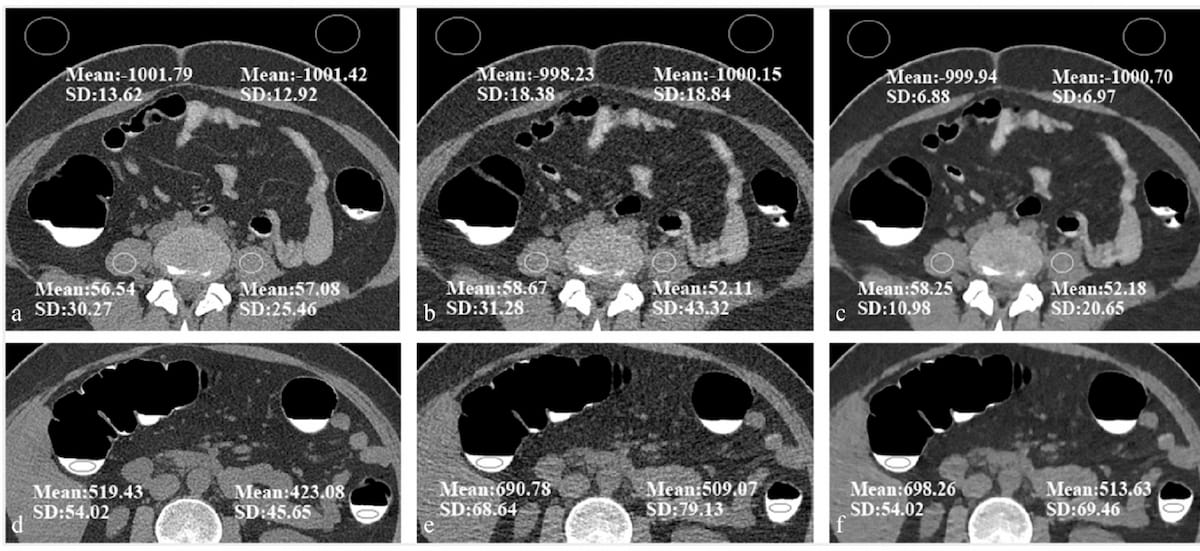Could deep learning image reconstruction be a game-changer for computed tomography colonography (CTC)?
For the study, recently published in Academic Radiology, researchers compared the image quality for low-dose deep learning reconstruction (LD-DLR) to low-dose iterative reconstruction (LD-IR) and routine-dose iterative reconstruction (RD-IR) for CTC images from 270 study participants (mean age of 47.94). The study authors examined noise, signal-to-noise ratio (SNR), contrast-to-noise ratio (CNR) as well as subjective image quality on a five-point scale, according to the study.
The researchers found the use of LD-DLR reduced effective dosing for low-dose CTC by 83.18 percent (0.86 mSv) in comparison to LD-IR (5.18 mSv). Subjective image quality for LD-DLR was comparable to RD-IR (3.61 out of 5 for both) and was 25 percent higher than that of LD-IR (2.7 out of 5).
The use of LD-DLR also led to consistently lower noise and higher SNR and CNR than LD-IR and RD-IR regardless of body mass index (BMI0 levels for patients, according to the study authors. For patients with a normal BMI range, the CNR and SNR for LD-DLR (132.72 and 4.32 respectively) were more than double that of RD-IR (54.43 and 2.01 respectively).
“The results showed that compared to (iterative reconstruction), (deep learning reconstruction) significantly reduced image noise, improved SNR and CNR, and had a higher subjective image quality score at an effective dose below 1 mSv in low-dose CTC,” wrote lead study author Yanshan Chen, M.D., who is affiliated with the Department of Radiology and the Biomedical Innovation Center at the Sixth Affiliated Hospital at Sun Yat-sen University in Guangdong, China, and colleagues.
Subjective image quality assessments for LD-DLR were significantly higher than those for LD-IR across different BMI groups, according to the study authors. The researchers noted that image quality for obese patients was rated higher for RD-IR (4.17 out of 5) in comparison to LD-DLR (3.533 out of 5) but LD-DLR image quality was otherwise comparable with subjective assessments of RD-IR CTC images.
“The results in our study indicate that, at a radiation dose below 1 mSv, the quality of LD-DLR is not significantly affected by BMI and may apply to people of different body sizes, although the SNR of LD-DLR tended to decrease with increasing BMI,” added Chen and colleagues.
Three Key Takeaways
- Significant reduction in radiation dose. The use of low-dose deep learning reconstruction (LD-DLR) in computed tomography colonography (CTC) resulted in an impressive 83.18 percent reduction in effective dosing compared to low-dose iterative reconstruction (LD-IR), making it a promising technology for minimizing radiation exposure during CTC.
- Comparable image quality to routine-dose reconstruction. The subjective image quality of LD-DLR was found to be comparable to routine-dose iterative reconstruction (RD-IR), with both scoring 3.61 out of 5. This suggests that LD-DLR may offer a potential alternative to standard reconstruction techniques without compromising image quality.
- Consistently improved parameters for image quality. LD-DLR consistently demonstrated lower noise levels and higher signal-to-noise ratio (SNR) and contrast-to-noise ratio (CNR) compared to both LD-IR and RD-IR, irrespective of body mass index (BMI). These improvements in image parameters were observed across different BMI levels, indicating the potential applicability of LD-DLR to patients of various body sizes.
For the study, the researchers noted they were able to achieve the lower radiation dosing by applying the IR algorithm with reductions in tube current and voltage. While reducing the tube voltage from 120 to 100 kVp led to 20 and 16 percent reductions in CTDLvol and DLP respectively, Chen and colleagues noted a corresponding 32 percent increase in image noise. Accordingly, tube current reduction also plays a key role, according to the study authors.
“Reducing the tube current makes it easier to detect lesions because (of) higher attenuation of tagged fecal materials in the colorectum and higher contrast between tagged fecal materials and soft tissues,” pointed out Chen and colleagues.
(Editor’s note: For related content, see “Emerging Perspectives on Computed Tomography Colonography,” “CMS Declines to Expand Coverage of Computed Tomography Colonography (CTC) for Medicare Beneficiaries” and “Study Finds CT Colonography is Extremely Underutilized.”)
In regard to study limitations, the authors noted there was no analysis of the image reconstruction techniques for lesion detection and acknowledged the subjective nature of image quality assessments in the study. The researchers also cautioned against broader extrapolation of the findings with the DLR method in this study, noting the comparison to only one iterative reconstruction algorithm.
